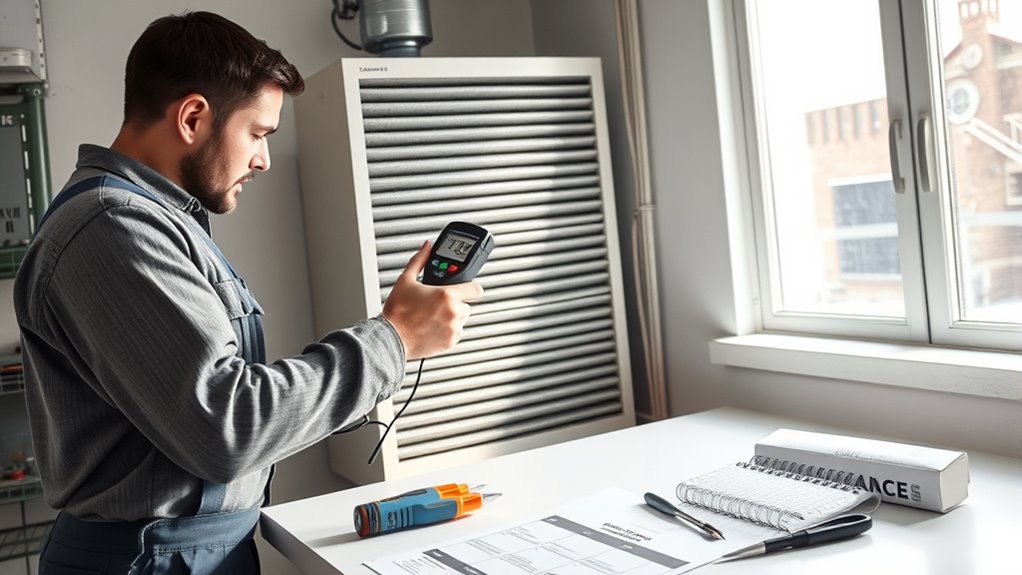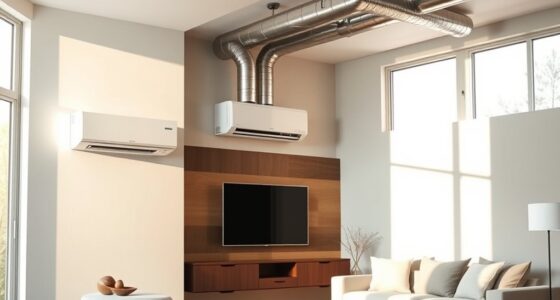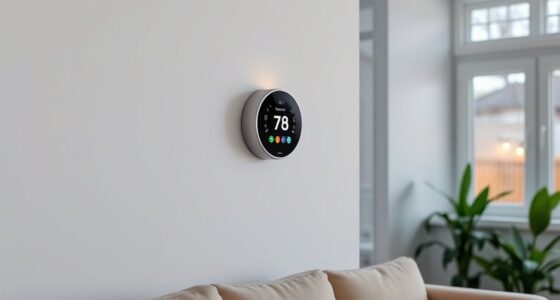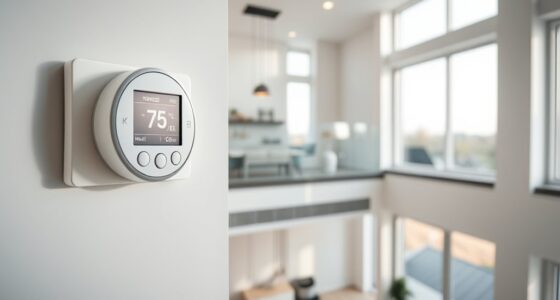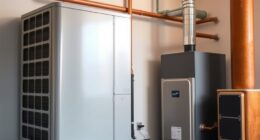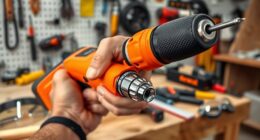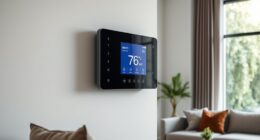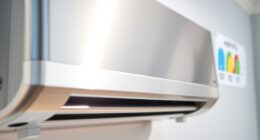To keep your HVAC system running smoothly year-round, start with inspecting and replacing filters every 1-3 months to improve air quality and efficiency. Check vents and registers for blockages, and clear debris around the outdoor unit for ideal heat exchange. Schedule a professional tune-up to verify electrical connections and clean crucial components. Upgrading to a smart thermostat can help save energy. Continue with these steps to guarantee your system stays efficient and dependable all season long.
Key Takeaways
- Inspect and replace air filters every 1-3 months to ensure optimal airflow and indoor air quality.
- Check and clean vents and registers to prevent dust buildup and maintain efficient airflow.
- Clear debris from the outdoor condenser unit and straighten bent fins for optimal heat exchange.
- Schedule a professional HVAC tune-up to verify system components and improve efficiency.
- Upgrade to programmable or smart thermostats to enhance energy savings and maintain consistent indoor temperature.
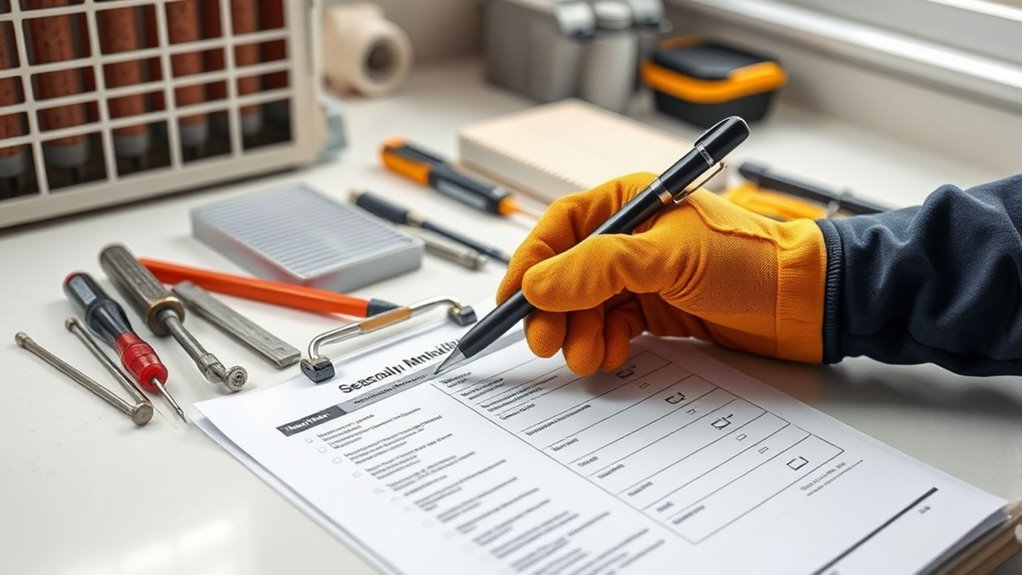
Maintaining your HVAC system is essential for guaranteeing it runs efficiently and lasts longer. When you prioritize proper maintenance, you’re not only saving money on energy bills but also improving the overall comfort and safety of your home. One of the key aspects of seasonal HVAC upkeep is focusing on energy efficiency and indoor air quality. These elements directly impact your health, comfort, and expenses, making regular checks and maintenance a must.
Start by inspecting your air filters. Dirty or clogged filters restrict airflow, forcing your system to work harder and consume more energy. Replacing filters every one to three months, especially during peak seasons, keeps your system running smoothly. Clean filters also enhance indoor air quality by trapping dust, pollen, pet dander, and other pollutants, which is particularly important if anyone in your household suffers from allergies or respiratory issues. Additionally, check your vents and registers to ensure they’re free of dust and debris. Proper airflow not only boosts energy efficiency but also promotes better indoor air quality by preventing buildup of contaminants.
Inspect and replace air filters regularly to improve airflow and indoor air quality.
Next, examine your outdoor unit, especially before the cooling season begins. Clear away leaves, dirt, and debris from around the condenser to improve airflow and prevent overheating. Make sure the fins are straight and unobstructed; gently straighten bent fins with a fin comb if necessary. This helps maintain superior heat exchange, reducing strain on the compressor and improving energy efficiency. Also, check the refrigerant lines for leaks or damage, as low refrigerant levels can decrease cooling performance and increase energy consumption. Having a professional handle refrigerant issues is advisable for safety and compliance.
Another critical step is scheduling a professional tune-up. While you can handle basic inspections yourself, a licensed technician can thoroughly evaluate your system’s components, including electrical connections, thermostat calibration, and ductwork. Properly calibrated thermostats ensure your HVAC system operates only when needed, saving energy and maintaining consistent indoor temperatures. During the tune-up, ask the technician to check and clean the blower motor, evaporator coil, and other vital parts—these elements directly influence energy efficiency and indoor air quality. Dirty coils or malfunctioning blowers can cause your system to work harder, reducing lifespan and increasing utility bills.
Finally, consider upgrading your thermostat to a programmable or smart model. This allows you to better control temperature settings, reduce energy waste when you’re away, and maintain consistent indoor air quality. Regular seasonal maintenance also includes paying attention to energy efficiency, which can significantly reduce your utility costs and environmental impact. Proper seasonal maintenance, including these steps, ensures your HVAC system operates at peak performance, providing a comfortable, healthy living environment while saving you money on energy costs. Regular upkeep is a small investment that yields significant benefits over the long run.
Frequently Asked Questions
How Often Should I Replace My HVAC Filters?
You should replace your air filter every 1 to 3 months, depending on the air filter lifespan and your home’s conditions. A good filter replacement schedule keeps your HVAC system running efficiently and improves indoor air quality. If you have pets, allergies, or live in a dusty area, consider replacing filters more frequently. Regularly checking your filter helps guarantee peak performance and prolongs your system’s lifespan.
Can I Perform Seasonal HVAC Maintenance Myself?
You can absolutely tackle seasonal HVAC maintenance yourself with some DIY tips and the right maintenance tools. Picture yourself confidently inspecting filters, cleaning vents, or checking thermostats, feeling accomplished as you maintain your system’s efficiency. While simple tasks are manageable, remember that complex repairs are best left to professionals. Follow safety guidelines, gather quality tools, and enjoy the satisfaction of keeping your HVAC running smoothly all season long.
What Are Signs My HVAC System Needs Urgent Repair?
If you notice warning signs like strange noises, foul odors, inconsistent temperatures, or increased energy bills, your HVAC system likely needs urgent repairs. Don’t ignore these signs, as they could indicate serious issues. You should schedule a professional inspection promptly to prevent further damage. Addressing urgent repairs early helps maintain system efficiency and extends its lifespan, ensuring your home stays comfortable and safe.
How Does Outdoor Climate Affect HVAC Maintenance Needs?
Imagine a hot summer day, outdoor temperature soaring and humidity levels high. You notice your HVAC system working harder, which means you need more frequent maintenance. When outdoor conditions fluctuate—like cold winters or humid summers—your system faces extra strain. Regular checks help it run efficiently, preventing breakdowns. Keep an eye on outdoor temperature and humidity levels, so you can schedule maintenance proactively and stay comfortable year-round.
Are There Eco-Friendly HVAC Maintenance Options Available?
Yes, there are eco-friendly HVAC maintenance options available. You can choose systems that incorporate green technology, like energy-efficient filters and biodegradable cleaning products. Regular maintenance helps improve your system’s energy efficiency, reducing overall environmental impact. You should also consider upgrading to smart thermostats and renewable energy sources when possible. These choices not only lower your carbon footprint but can also save you money on energy bills in the long run.
Conclusion
By following this seasonal HVAC maintenance checklist, you’re keeping your system in tip-top shape, ready to tackle the upcoming weather. Think of your HVAC as the heartbeat of your home—when it’s well-maintained, everything runs smoothly. Don’t let neglect turn your comfort into chaos; instead, stay proactive and enjoy a cozy, worry-free season. Remember, a little upkeep now saves you from big headaches later—like watering a plant to keep it thriving.
